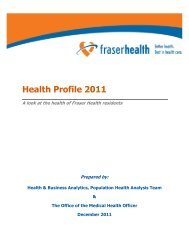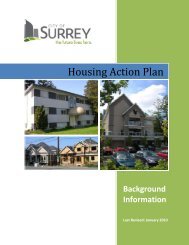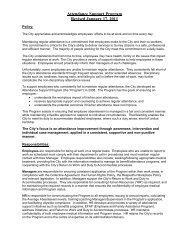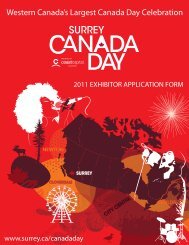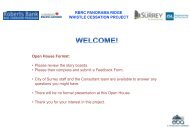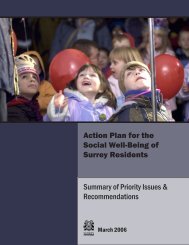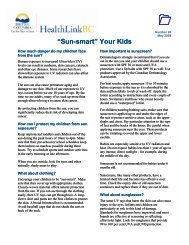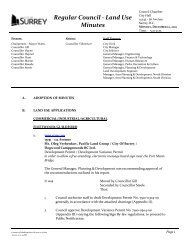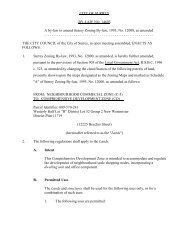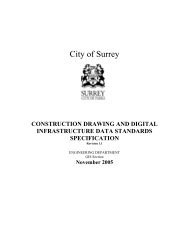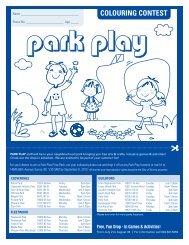Blackie Spit Park: Wildlife Habitat Enhancement Plan - City of Surrey
Blackie Spit Park: Wildlife Habitat Enhancement Plan - City of Surrey
Blackie Spit Park: Wildlife Habitat Enhancement Plan - City of Surrey
Create successful ePaper yourself
Turn your PDF publications into a flip-book with our unique Google optimized e-Paper software.
Management Unit 11: Dog-<strong>of</strong>f-leash Area<br />
1.0 Existing Conditions<br />
Management Unit 11 is primarily an open, sparsely vegetated dredge spoil area (Drawing 8)<br />
(Figure 32). Recent management activities have included removal <strong>of</strong> much <strong>of</strong> the broom and<br />
blackberry that grew along the west side, the creation <strong>of</strong> a knoll, the addition <strong>of</strong> an organic veneer,<br />
and revegetation with grasses. Most <strong>of</strong> the organic veneer has dried on the surface and become<br />
fragmented. The grasses are short, covering about 50% <strong>of</strong> the ground, and were still green and<br />
growing at the time <strong>of</strong> the site visit on August 10, 2001.<br />
Along the west side, a thicket <strong>of</strong> blackberry and knotweed remains (Figure 32, mid right side). Along<br />
the east side, between the fence and the birch-covered dyke <strong>of</strong> MUs 1 and 12 are some rowan trees,<br />
and blackberry is beginning to fill in the area.<br />
In the south west corner, south <strong>of</strong> the new fence along the canal, blackberry grows between the multi<br />
use trail to the west and a more open area to the east where a variety <strong>of</strong> small trees, shrubs, and forbs<br />
grow. The most abundant species in the more open area is tansy. Goldenrod, plantain, and common<br />
horsetail are also common. Woody vegetation consists <strong>of</strong> a domestic apple tree, three black<br />
hawthornes, three rowan trees, and two Pacific crabapples (Figure 33).<br />
A few native trees have been planted along the north side <strong>of</strong> the south fence and along the trail<br />
(Figure 32). Patches <strong>of</strong> trees and shrubs have been planted in MU 1 on the south side <strong>of</strong> the fence<br />
and around the new channel (Figure 9).<br />
2.0 Goals and Objectives<br />
Species Management Goal<br />
• Sparse grass and wild flowers.<br />
• Shrub/tree borders.<br />
• Passerine bird species associated with the shrubby edges.<br />
• Insects associated with wildflowers.<br />
• Occasional use by grassland and opportunistic bird species.<br />
<strong>Habitat</strong> Management Objectives<br />
• Continue to experiment with topsoil and short-growing grass & wildflower mixes (native species<br />
not necessary but avoid species that spread & become weedy).<br />
• Continue invasive species removal <strong>of</strong> central open areas (e.g., broom, knotweed, blackberries);<br />
• Maintain existing extent <strong>of</strong> shrub/tree border east <strong>of</strong> the north-west fence.<br />
• In the southwest <strong>of</strong> this unit, south <strong>of</strong> the east-west fence, maintain the blackberry border along<br />
the all purpose trail for both habitat and access control purposes.<br />
• Along the west side <strong>of</strong> this unit, plant suitable native shrub and small tree species along and<br />
south <strong>of</strong> the east-west fence (east <strong>of</strong> the blackberries) and in place <strong>of</strong> the invasive species<br />
currently growing by the trail north <strong>of</strong> the fence.<br />
• Increase fencing to prevent access to the south estuary, as required.<br />
<strong>Blackie</strong> <strong>Spit</strong> <strong>Park</strong>: <strong>Wildlife</strong> <strong>Habitat</strong> <strong>Enhancement</strong> <strong>Plan</strong> – Management Unit 11 56



